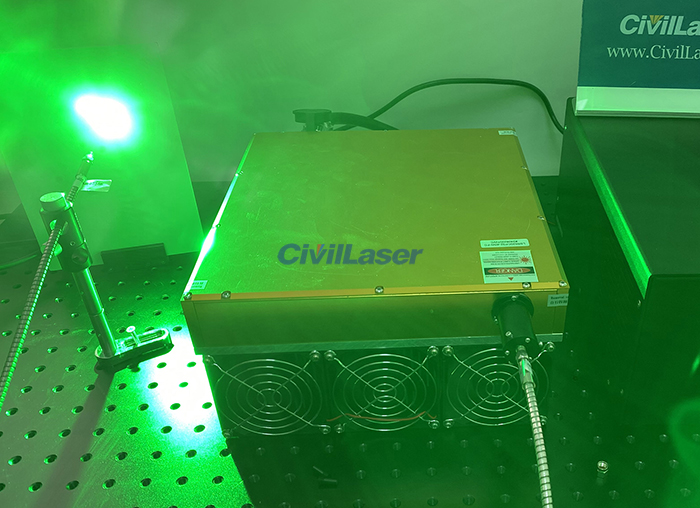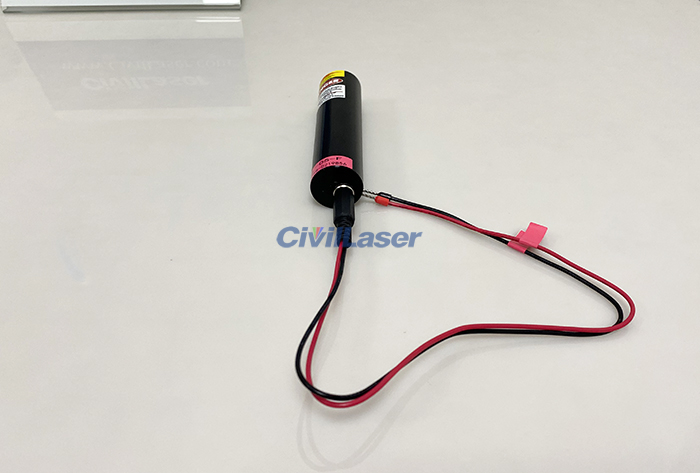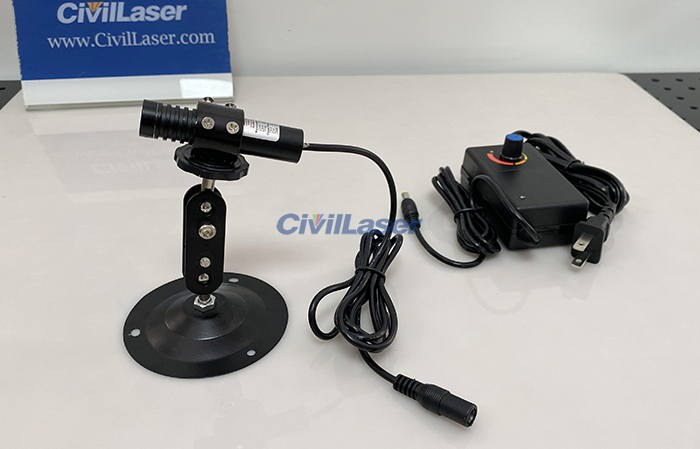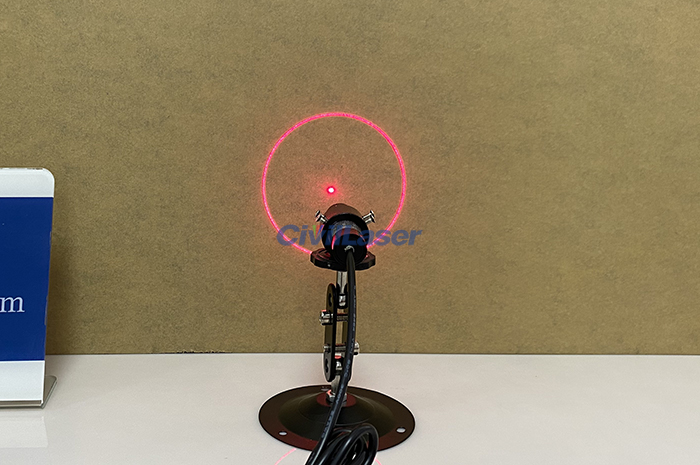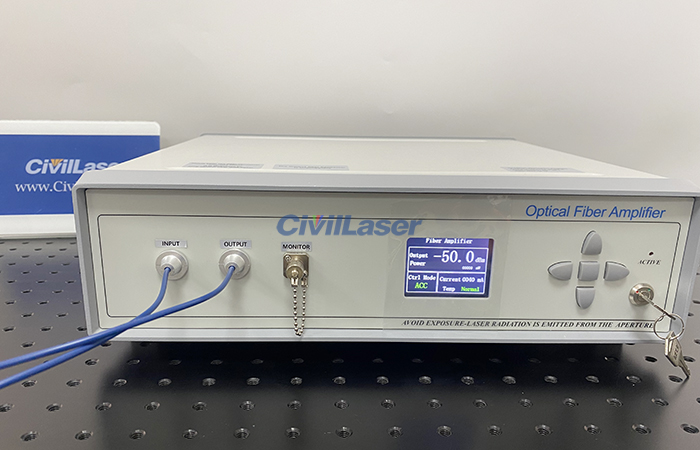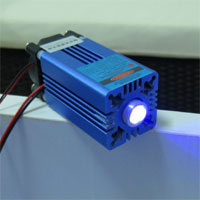40000mW Strong Laser Beam 520nm Green Lab Laser System
As an important part of modern science and technology, fiber-coupled lasers play a key role in many fields with their high efficiency, stability and flexibility. Among them, the 520nm 40W fiber-coupled laser has become a leader in many applications with its unique wavelength and powerful power.
The 520nm 40W fiber-coupled laser belongs to the visible light band, which makes it perform well in applications that require a specific color light source. At the same time, its power output of up to 40 watts ensures powerful laser energy and is suitable for a variety of high-demand processing and measurement tasks.
This is a 520nm 40W high power green laser. The bottom of the laser head has a heat sink, which is an aluminum heat dissipation module with 3 fans. There are 3 working modes to choose from on the back of the power supply: CW/TTL/Analog. The regulator button on the power supply is used to adjust the operating current, thereby adjusting the laser output power.
Fiber-coupled lasers efficiently couple the laser beam generated by the laser diode into the optical fiber through precise fiber coupling technology. This process requires precise focal length adjustment and angle control to ensure that the beam can enter the optical fiber without loss and be stably transmitted along the path of the optical fiber. Fiber coupling technology not only improves the efficiency of laser transmission, but also enables the laser to maintain stable performance in complex environments.
Laser output after installing the optical fiber.

With its unique wavelength and powerful power, the 520nm 40W fiber-coupled laser has shown a wide range of application prospects in many fields. Its high efficiency, stability and flexibility make it an indispensable and important tool in modern technology. With the continuous advancement of technology and the continuous expansion of application fields, it is believed that the 520nm 40W fiber-coupled laser will play a greater role in more fields.
430nm 1W Semiconductor Laser Operation Video
Semiconductor lasers, also known as laser diodes, are lasers that use semiconductor materials as working materials to produce stimulated emission. Among the many semiconductor lasers, 430nm 1W semiconductor lasers have become a highly sought-after product in the market due to their unique technical characteristics and wide range of applications. This article will explore in depth the technical characteristics, application fields and market prospects of 430nm 1W semiconductor lasers.
The 430nm 1W semiconductor laser has a series of remarkable technical characteristics. First, its small size and light weight make it easy to integrate in various application scenarios. Secondly, the laser has high electro-optical conversion efficiency, long working life, low power consumption, and can be directly electrically modulated, making it easy to achieve optoelectronic integration with various optoelectronic devices. In addition, the 430nm wavelength gives the laser unique advantages in specific application fields, such as optical communications, sensing technology, and biomedicine.
Demonstration effect of 430nm 1W laser in indoor during daytime.
The 430nm 1W semiconductor laser has become a highly regarded product in the market with its unique technical characteristics and wide application fields. With the continuous advancement of technology and the continuous expansion of the market, this laser is expected to play an important role in more fields and make greater contributions to economic development and social progress.
FLH-1064-40-SM-B 1064nm 10W Fiber Laser Operation Video
This is a 1064nm 10W single-mode fiber laser. There are 2 fiber output interfaces. The ‘OUTPUT’ on the left is the actual laser output. The ‘MONITOR’ on the right is the synchronization signal output. The laser power of the synchronization signal output port is very low and is only used by customers in need.
The laser has a cooling fan. The RS232 interface here is used to connect to a computer. The current power can be displayed on the screen. The laser output power can be adjusted by buttons.
Use the buttons to adjust the laser output power:
The left and right arrow buttons select the digit, and the up and down arrow buttons adjust the value. The middle square button is the confirmation button. Turn the key to the right. The Active indicator lights up, and the laser starts outputting.
The parameter table, Spectral diagram and power stability test of this 1064nm laser.
1528~1603nm 100mW ASE Broadband SM Fiber Light Source
The fiber ASE broadband light source is an incoherent light source, which is the spontaneous radiation generated by the semiconductor laser pumping erbium-doped silica fiber, and the spectral flattening technology is introduced to achieve a broadband flat spectrum. The wavelength of the light source covers the C+L band, and the spectral flatness is better than 3dB. It is output through single-mode fiber or polarization-maintaining fiber, which is suitable for applications such as fiber sensing.
This is a C+L Band 100mW ASE broadband light source. The wavelength range is 1528nm~1603nm. The power can be adjusted by the button, and the adjustment accuracy is 1mW. The adjustment range is 10%~100%. We need to use infrared photosensitive film to observe the light spot of the laser in this band.
The test data report of this ASE broadband light source.
How to use the desktop ASE broadband light source:
Turn on the power switch on the back of the machine. After power on, the LCD displays the current power and wavelength range.
Press the middle square button to start setting the power. The left and right buttons are used to select the digit to be adjusted. The up and down buttons are used to adjust the value. Finally, press the middle square button to confirm the setting. The key is turned to ON, and the Active indicator lights up, indicating that the laser starts outputting.
532nm 5mW DPSS Laser Diode Module Video
The 532nm free optical path laser is a DPSS laser, and the spot mode is TEM00 mode. It adopts the APC working mode, which has the advantages of good spot mode and long-term working stability.
It is compact, strong and reliable, suitable for various industrial and scientific research purposes. Single longitudinal mode, can be used for interferometer. Let’s check it now.
This is a 532nm 5mW DPSS laser module. The operating voltage is DC 5V. The spot quality is very good, and the divergence angle is also very small. Beam Divergence is less than 1 mrad. We can customize the laser modules according to your requirements.
The spectrum of the 532nm laser module.
Circle with Point Laser Diode Module
In today’s rapidly changing science and technology, circular laser module, as an efficient and accurate positioning and identification tool, is gradually showing its unique charm and value in various fields. This article will deeply explore this cutting-edge technology from the aspects of the definition, working principle, application field and future development trend of circular laser module.
Today’s module is quite special. It is not the common circle. Its pattern is a perfect circle with a center point. Let’s check it now.
The head of the laser module can be rotated to adjust the focal length and change the thickness of the laser light. The built-in special lens makes the laser light appear in a circular shape. The power supply has an adjustment knob, which can adjust the voltage to change the laser output power and the brightness of the laser.
You can customize the circular laser of red/green/blue light. The divergence angle used here is 56°, and there is an option of 34°. There is a dot in the center here, or you can customize the center without a dot.
The circular spot at different distances.
Unlocking High-speed Transmission: In-depth Analysis of 40dBm Single-mode YDFA Technology
Ytterbium-doped fiber amplifier (YDFA) generates gain by pumping ytterbium-doped fiber with semiconductor laser and is used to amplify optical signals in the 1030~1080nm band. The output power is continuously adjustable and has the advantages of high gain and low noise. The desktop YDFA is convenient for experimental operation, and the user can adjust the pump current and output power through the panel buttons. A more compact modular YDFA is also provided to facilitate user system integration.
With the rapid development of optical communication technology, how to effectively enhance the intensity of optical signals and extend the transmission distance has become the focus of the industry. As an important technological innovation in this field, the ytterbium-doped fiber amplifier is gradually becoming a key device in the construction of optical communication networks with its excellent performance and broad application prospects.
The 40dBm ytterbium-doped fiber amplifier uses advanced ytterbium-doped fiber as the gain medium. Ytterbium is widely used in fiber amplifiers due to its unique energy level structure and efficient energy conversion characteristics. When pump light (usually high-power laser) is injected into ytterbium-doped fiber, ytterbium atoms absorb the energy of the pump light and undergo energy level transitions. Subsequently, when the optical signal passes through the fiber, the ytterbium atoms are stimulated to radiate photons of the same frequency as the signal light, thereby amplifying the optical signal.
It is a 1030~1070nm Ytterbium-doped fiber amplifier. The saturated output power is 40dBm @0dBm input. The 40dBm YDFA is a high-power amplifier, with an additional Monitor interface. The Monitor is used to monitor or synchronize signals with low power. And it has built-in cooling fan. Configured with RS2323 interface, available software or control command YDFA.

It supports two working modes of APC/ACC, and the two working modes can be switched by pressing the button. In APC working mode, the output power can be set. In ACC working mode, the working current can be set. Finally, press the middle square button to confirm.
The use of single-mode optical fiber as the transmission medium ensures high-quality transmission of optical signals. Single-mode optical fiber has small intermodal dispersion and is suitable for long-distance, high-speed optical communication applications.
The test data of YDFA-40-SM-B.




The 40dBm ytterbium-doped fiber amplifier has shown strong competitiveness and broad market space in the field of optical communication with its excellent performance and wide application prospects. With the continuous advancement of technology and the continuous growth of application demand, it is believed that this technology will play a more important role in the future and promote the rapid development of the optical communication industry.
460nm Semiconductor Laser Reaches a New Milestone of 60W
With the continuous advancement of science and technology, the 460nm 60W semiconductor laser will show its unique value in more fields. In the future, the laser is expected to play a more important role in biological imaging, optical communication, energy conversion and other fields. At the same time, with the continuous development of materials science and semiconductor technology, we have reason to believe that the performance of semiconductor lasers will be further improved, bringing more surprises and breakthroughs to human society.
As can be seen from the video, for a 60W laser, we need to add a heat sink to the bottom of the power supply, which is an aluminum heat dissipation module with 3 fans. On the back of the laser power supply, there are 3 working modes to choose from: CW/TTL/Analog. The two white ports on the data cable are the ports for the fan power supply, which also need to be plugged in.
The customer needs to be able to minimize the laser spot at a specified working distance. A beam expander collimator is added here, and the collimator is not provided by default. In addition, we can also customize the fiber-coupled output.
There are multiple groups of laser chips inside the laser. Here, two synchronous data lines are used to control the laser. 60 Watts is a very high power laser, the operator needs to wear laser protective glasses
In the field of modern science and technology, semiconductor lasers have become a shining star in the field of optical technology with their unique performance and broad application prospects. Among them, the 460nm 60W semiconductor laser has become the pinnacle of the blue light source field with its high power, high efficiency, high purity and other characteristics.
In short, the 460nm 60W semiconductor laser has become the pinnacle of the blue light source field with its excellent performance and broad application prospects. We have reason to believe that it will continue to play an important role in the future development of science and technology and contribute to the progress of human society.
532nm 5000mW Strong Green Laser Beam Lab Laser System
The 532nm DPSS laser is a high-performance solid-state laser that uses diode pumping technology to produce stable, high-power green light output at a wavelength of 532 nanometers. This laser is widely used in scientific research, industrial processing, biomedicine, and communications for its excellent beam quality and high energy conversion efficiency. Whether high-precision cutting, drilling or fine marking is required, the 532nm 5W DPSS laser can provide a reliable and efficient solution. Its compact design and long-life pump diode make this laser an ideal choice for various applications.
This is a 2024 new model 532nm 5W high quality DPSS laser. The new laser has better heat dissipation and better stability than the 2023 model. It supports both CW and modulation working modes. It is TEM00 spot, and the beam quality is very good. The beam quality test data is around 1.06, which is Near-Perfect Beam Quality.
The laser needs to be preheated for about 20 seconds before laser output can be generated. Adjust the laser output power to the maximum.
The actual test data of laser.
Newest! 760nm Laser + Power Supply Integrated Fiber Laser
The 760nm 1500mW fiber laser integrated machineThe 760nm 1500mW fiber laser integrated machine is a laser device that integrates high power, high precision and high stability. It uses a 760nm wavelength laser light source with a maximum output power of up to 1500mW, which can meet the needs of various high-precision and high-demand industrial applications.
is a laser device that integrates high power, high precision and high stability. It uses a 760nm wavelength laser light source with a maximum output power of up to 1500mW, which can meet the needs of various high-precision and high-demand industrial applications.













